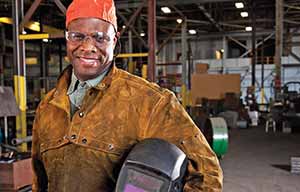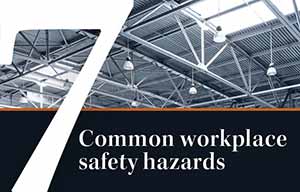Working with nanotechnology
Data on health effects is limited

Nanomaterials can be found in missiles, satellites and airplanes, as well as more everyday items such as sunscreens, soaps, sporting goods, batteries and furniture.
But what are they exactly?
Nanomaterials – materials that have at least one dimension (height, width or length) that is smaller than 100 nanometers – are chemical substances whose microscopic size gives them properties they don’t possess in their larger form. These properties are used in numerous commercial products to strengthen them, make them weigh less, or keep them colder or hotter. Naturally occurring nanomaterials include soot and volcanic ash.
So recent is the commercial use of nanomaterials – approximately the turn of the century – that data on their long-term health effects and guidance for worker safety is limited.
What is known are the potential hazards of the bulk versions of nanomaterials. However, the materials’ properties and their potential to enter human bodies change when they’re in microscopic form. Further, some nanomaterials aren’t simply smaller versions of the bulk material – they’re engineered.
In 2012, Raymond David, then the manager of toxicology for BASF Corp., which states on its website that it uses nanotechnology “to develop new products and improve existing ones,” spoke at a workshop sponsored by the American Chemistry Council’s Nanotechnology Panel. In his presentation, David said, “It is not practical to wait for [the American Conference of Governmental Industrial Hygienists], NIOSH or any other national body to develop [occupational exposure limit] values – and may not be applicable for a broad range of nanomaterials. Each company needs to press forward with a system on its own.”
This void of knowledge to ensure the safety and health of those who work with or near nanomaterials drives the research of NIOSH, occupational health academia and corporations. Their approach to worker safety is for employers and employees to proceed with utmost caution until more is known about health effects, exposure limits and protection processes.
Right here, right now
A 2011 study funded by the National Science Foundation looked at nanotechnology 10 years into the future and estimated that 6 million nanotechnology workers will be needed worldwide by 2020. About 2 million of those jobs are expected to be in the United States. The predicted rise in the number of workers adds urgency to the research needed to protect them.
In the United States, NIOSH has taken the lead on this quest, headed by Chuck Geraci, the agency’s associate director for nanotechnology. One of the 20 agencies in the 18-year-old federal National Nanotechnology Initiative, NIOSH – through its Nanotechnology Research Center – has a field studies team that provides free onsite assessments of labs and manufacturing facilities; produces guidance materials for employers and employees; and collaborates with agencies, academia and private organizations on research.
On Jan. 31, NIOSH included nanotechnology as one of six objectives in its National Occupational Research Agenda for Manufacturing: “Examine emerging risks from new technologies and explore ways in which new technologies can advance occupational safety and health in manufacturing.”
NORAs identify the knowledge and actions needed to pinpoint occupational risk factors to stimulate innovative research and workplace interventions to help prevent avoidable negative health outcomes for workers.
“There’s never any debate about how quickly nanotechnology or nanoscale-materials science has evolved in the last 10 years,” Geraci said. “People continue to refer to it as the fourth industrial revolution – and it really is. That’s the challenging part – it’s moving very, very fast. So, the question is, are we keeping up with understanding the health and the safety or the environmental impact of all that?
“It’s been a real challenge, but what I continue to say is, the good news is the health and safety professionals are working right out front with the people developing the science to try to answer those questions. Unlike some of the history of other materials in the past, like asbestos or vinyl chloride or various other chemical contaminants, we’re not asking questions after we find disease or injury or illness. We’re right out front doing the toxicology as these materials are being developed, so we won’t be sitting down 20 years from now saying, ‘Gee, I wish we had looked at this.’”
In 2017, the World Health Organization released the first guidelines on protecting workers from the potential effects of nanomaterials. The guidelines stress:
- Taking a precautionary approach
- Using the Hierarchy of Controls
- Grouping nanomaterials by toxicity, fibrous characteristics and granular biopersistence
- Educating and training workers on nanomaterials
- Involving workers in each aspect of assessment and control
In March, NIOSH published four documents to help employers safeguard their workers who handle nanomaterials:
- Workplace Design Solutions: Protecting Workers during Nanomaterial Reactor Operations
- Workplace Design Solutions: Protecting Workers during the Handling of Nanomaterials
- Workplace Design Solutions: Protecting Workers during Intermediate and Downstream Processing of Nanomaterials
- Controlling Health Hazards When Working with Nanomaterials: Questions to Ask Before You Start
“Researching, developing and utilizing these nano properties is at the heart of new technology, just as worker safety is at the heart of what we do at NIOSH,” agency Director John Howard said. “The information contained in these new workplace design solution documents provide employers with strategic steps toward making sure their employees stay safe while handling nanomaterials.”
Looking ahead
NIOSH’s Nanotechnology Research Center states the case for its mission on its “Burden, Need and Impact” webpage: “While it is too early to identify the exact burden of [engineered nanomaterials] to workers, it is reasonable to assume that health effects from exposure to engineered nanoparticles could be similar to ultrafine air pollution or other dusts and fumes that cause pulmonary and cardiovascular effects. Some engineered nanoparticles appear to be 10 to 100 times more reactive or potent than their bulk counterparts, so one would expect a commensurate increase in burden for a given exposure.”
The website further states that, “Based on these developing trends, burden in terms of morbidity and mortality has the potential to be large, significant and costly. Failure to develop the technology responsibly, including worker protection, may ultimately place a burden on capital, entrepreneurial investment and ultimate benefit to society.”
NIOSH’s Nanotechnology Research Center has identified research goals for the next five years as well as 10 critical topic areas: toxicity and internal dose, risk assessment, epidemiology and surveillance, engineering controls and personal protective equipment, measurement methods, exposure assessment, fire and explosion safety, recommendations and guidance, global collaborations, and applications.
Established in 2004, the Nanotechnology Research Center has published more than 1,300 papers, and its 2017 paper on an engineered nanomaterial – multi-walled carbon nanotubes – and its toxicology at different stages of its life cycle was the first of its kind. It appeared in the American Chemistry Council’s journal Nano Letters. Simply put, if a nanomaterial is more or less hazardous at different steps in its manufacturing cycle, employers can adjust worker protection accordingly.
“It was a very important step for NIOSH to take to help quantify and frame the discussion of hazard and risk at different stages of the life cycle of these materials as they continue to grow in their use in commerce,” Geraci said. “That’s probably one of the big shifts we’ve seen in some of our basic research in toxicology.”
Out of the lab
Joe Sprengard Jr. is co-founder and CEO of Cincinnati-based General Nano, a manufacturer of Veelo, a material made from engineered carbon nanotubes. The material then is formed into sheets, film, tape and coating for use in airplanes, satellites and missiles. Boeing named General Nano its 2015 technology supplier of the year.
Veelo is a classic example of the value of nanomaterials. For instance, the use of carbon nanotubes in Veelo Shield, used on data cables, reduces the weight of the cables by up to 40 percent.
Sprengard is not a scientist. He’s a businessman. He knows that the potential health hazards of nanomaterials are being studied, and said he is happy to make use of that expertise to keep safe the 70 or so workers who are hands-on with the materials used to produce Veelo products.
NIOSH field studies team representatives have visited General Nano and the company it contracts to handle carbon nanotubes, NanoSperse. The NIOSH team helped General Nano make safety upgrades to the chemical vapor deposition reactor it bought to make carbon nanotubes. Workers wore NIOSH measuring devices over multiple days to test for airborne particulates.
“We don’t wake up every day with the responsibility of measuring nanomaterials,” Sprengard said, “so the most important thing we can do is maintain great relationships with the government entities that monitor that and regulate that and counsel folks like us on best practices, then take those best practices and apply them. In terms of the right protocols, we would never have the resources of the federal government to really get the depth of quality of information to really help us administer those.”
Nanomaterials are most dangerous in powder form, so workers wear coats, respirators, glasses and gloves, Sprengard said. Once the nanomaterials securely are mixed into the end product, workers only need to wear glasses, coats and gloves. As NIOSH and others study nanomaterials’ varying risks along the manufacturing process, organizations can adjust protections consistent with their unique materials and processes.
Sprengard’s advice is clear: Leverage the knowledge of the experts in this rapidly evolving area of materials and worker safety science. “That’s why NIOSH was there, from handling of powdered material to the point of dispersing it to the point of forming sheet material, so we knew what exposure risks were there and how to address them,” he said. “We have overprotected, not underprotected, because that’s just the right thing to do.”
Popular articles from the Safety+Health archives
Post a comment to this article
Safety+Health welcomes comments that promote respectful dialogue. Please stay on topic. Comments that contain personal attacks, profanity or abusive language – or those aggressively promoting products or services – will be removed. We reserve the right to determine which comments violate our comment policy. (Anonymous comments are welcome; merely skip the “name” field in the comment box. An email address is required but will not be included with your comment.)




